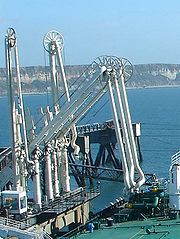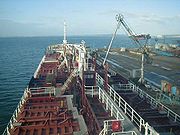
Marine loading arm
Encyclopedia

Oil tanker
An oil tanker, also known as a petroleum tanker, is a merchant ship designed for the bulk transport of oil. There are two basic types of oil tankers: the crude tanker and the product tanker. Crude tankers move large quantities of unrefined crude oil from its point of extraction to refineries...
or chemical tanker
Chemical tanker
A chemical tanker is a type of tanker designed to transport chemicals in bulk.Ocean-going chemical tankers generally range from to in size, which is considerably smaller than the average size of other tanker types due to the specialised nature of their cargoes and the size restrictions of the...
to a cargo terminal. Genericized trademark
Genericized trademark
A genericized trademark is a trademark or brand name that has become the colloquial or generic description for, or synonymous with, a general class of product or service, rather than as an indicator of source or affiliation as intended by the trademark's holder...
s such as Chiksan (often misspelled Chicksan) are often used to refer to marine loading arms regardless of their manufacturer.
Operation and design
A marine loading armLoading arm
A loading arm permits the transfer of liquid or liquefied gas from one tank to another through an articulated pipe system consisting of rigid piping and swivel joints to obtain flexibility....
is an alternative to direct hose hookups that is particularly useful for larger vessels and transfers at higher loading rates and pressures. Controlled manually or hydraulically, a loading arm employs swivel joints and can, to some extent, follow the movement of a moored vessel. Many loading arm systems feature quick-connect fittings. Gasket
Gasket
thumb|sright|250px|Some seals and gaskets1. [[o-ring]]2. fiber [[Washer |washer]]3. paper gaskets4. [[cylinder head]] [[head gasket|gasket]]...
or o-ring
O-ring
An O-ring, also known as a packing, or a toric joint, is a mechanical gasket in the shape of a torus; it is a loop of elastomer with a disc-shaped cross-section, designed to be seated in a groove and compressed during assembly between two or more parts, creating a seal at the interface.The O-ring...
arrangements are required to make a secure seal to the ship's manifold flange. A loading arm must be drained or closed off before the connection is broken off. This is usually done in two ways. For fuels such as gas oil and diesel, the lines can be blown out with high pressure air. In the case of fuels such as kerosene or petrol, the lines can be stripped with pumps.
Loading arms can handle both liquids and gases, in a wide range of viscosities and temperatures. Cargoes from liquid sulphur to liquefied natural gas
Liquefied natural gas
Liquefied natural gas or LNG is natural gas that has been converted temporarily to liquid form for ease of storage or transport....
are moved through marine loading arms. Loading arms service vessels in a wide range of sizes, from small river barges to the largest supertankers.
Various designs exist, and specific installations can be tailored for a given port based on considerations such as vessel size, cargo flow rate and cargo temperature. Environmental constraints, such as the range of tide, wind conditions, and earthquake tolerance can also affect choice of loading arm. A loading arm installation may include add-ons such as hydraulic or manual quick connect couplers, position monitoring systems, emergency release systems, and piggyback vapor return lines.
Compared to cargo hoses, the loading arm's main drawback is its comparative lack of flexibility.
History

Branobel
The Petroleum Production Company Nobel Brothers, Limited,or Branobel , was an oil company set up by Ludvig Nobel and Baron Peter von Bilderling, in Baku, Azerbaijan...
tanker Nordenskjöld was taking on kerosene
Kerosene
Kerosene, sometimes spelled kerosine in scientific and industrial usage, also known as paraffin or paraffin oil in the United Kingdom, Hong Kong, Ireland and South Africa, is a combustible hydrocarbon liquid. The name is derived from Greek keros...
in Baku
Baku
Baku , sometimes spelled as Baki or Bakou, is the capital and largest city of Azerbaijan, as well as the largest city on the Caspian Sea and of the Caucasus region. It is located on the southern shore of the Absheron Peninsula, which projects into the Caspian Sea. The city consists of two principal...
. The ship was connected to the pier with a simple piece of pipe. While loading, the ship was hit by a gust of wind and the cargo pipe carrying was jerked away from the hold. Kerosene then spilled onto the deck and down into the engineroom, where mechanics were working in the light of kerosene lanterns. The ship then exploded, killing half the crew. Ludvig Nobel
Ludvig Nobel
Ludvig Immanuel Nobel was an engineer, a noted businessman and a humanitarian. One of the most prominent members of the Nobel family, he was the son of Immanuel Nobel and Alfred Nobel's older brother...
responded to the disaster by creating a flexible, leakproof loading pipe which was much more resistant to spills.
Chiksan brand marine loading arm manufacturer FMC Technologies
FMC Technologies
FMC Technologies, Incorporated , is an American oil and gas equipment and services technology company. FMC Technologies was incorporated in 2000 when FMC Corporation divested its machinery businesses...
claims to have built the world's first all-steel marine loading arm in 1956 and to have over 8,000 units installed worldwide.

